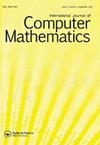具有时变系数的(2 + 1)维耦合非线性演化方程的高阶呼吸、整体和混合解
IF 1.3
4区 数学
Q2 MATHEMATICS, APPLIED
International Journal of Computer Mathematics
Pub Date : 2023-05-26
DOI:10.1080/00207160.2023.2219349
引用次数: 0
摘要
本文利用Hirota双线性方法研究了非均匀介质中一类(2 + 1)维耦合非线性时变系数演化方程。结合长波极限法和复共轭变换,初步构造了高阶呼吸解和块状解。此外,通过对参数的线性约束,导出了n孤子解、块解和呼吸解之间的混合解。同时,以图像的形式直观地展示了一些特殊混凝土解在不同时变系数下的动态演化行为。本文章由计算机程序翻译,如有差异,请以英文原文为准。
Higher-order breather, lump and hybrid solutions of (2 + 1)-dimensional coupled nonlinear evolution equations with time-dependent coefficients
This paper investigates a class of (2 + 1)-dimensional coupled nonlinear evolution equation with time-dependent coefficients in an inhomogeneous medium via the Hirota bilinear method. Combining the long wave limit method and complex conjugate transform, the higher-order breather and lump solutions are initially constructed. Furthermore, hybrid solutions among N-soliton, lump and breather solutions are derived by linear constraints on the parameters. Meanwhile, the dynamic evolution behaviour of some special concrete solutions under different time-dependent coefficients is presented visually in the form of images.
求助全文
通过发布文献求助,成功后即可免费获取论文全文。
去求助
来源期刊
CiteScore
3.60
自引率
0.00%
发文量
72
审稿时长
5 months
期刊介绍:
International Journal of Computer Mathematics (IJCM) is a world-leading journal serving the community of researchers in numerical analysis and scientific computing from academia to industry. IJCM publishes original research papers of high scientific value in fields of computational mathematics with profound applications to science and engineering.
IJCM welcomes papers on the analysis and applications of innovative computational strategies as well as those with rigorous explorations of cutting-edge techniques and concerns in computational mathematics. Topics IJCM considers include:
• Numerical solutions of systems of partial differential equations
• Numerical solution of systems or of multi-dimensional partial differential equations
• Theory and computations of nonlocal modelling and fractional partial differential equations
• Novel multi-scale modelling and computational strategies
• Parallel computations
• Numerical optimization and controls
• Imaging algorithms and vision configurations
• Computational stochastic processes and inverse problems
• Stochastic partial differential equations, Monte Carlo simulations and uncertainty quantification
• Computational finance and applications
• Highly vibrant and robust algorithms, and applications in modern industries, including but not limited to multi-physics, economics and biomedicine.
Papers discussing only variations or combinations of existing methods without significant new computational properties or analysis are not of interest to IJCM.
Please note that research in the development of computer systems and theory of computing are not suitable for submission to IJCM. Please instead consider International Journal of Computer Mathematics: Computer Systems Theory (IJCM: CST) for your manuscript. Please note that any papers submitted relating to these fields will be transferred to IJCM:CST. Please ensure you submit your paper to the correct journal to save time reviewing and processing your work.
Papers developed from Conference Proceedings
Please note that papers developed from conference proceedings or previously published work must contain at least 40% new material and significantly extend or improve upon earlier research in order to be considered for IJCM.

 求助内容:
求助内容: 应助结果提醒方式:
应助结果提醒方式:


